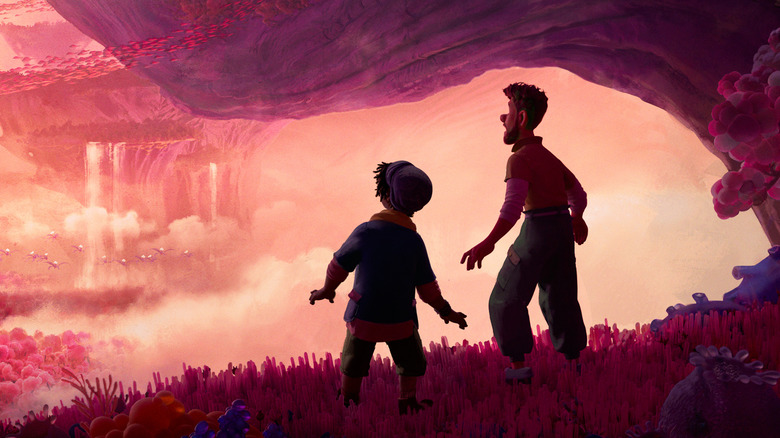Strange World (Nguyen, 2022)
In 1989, when I saw The Little Mermaid as a freshman in college, I did not know that I was watching the beginning of the Disney “renaissance.” I just knew it was a good movie.
The Disney of my childhood was The Aristocats, The Fox and the Hound, and The Black Cauldron. Sure there was an occasional superior offering (like The Great Mouse Detective), but the brand meant cheaper-looking animation that was a far cry from the lush detail of Sleeping Beauty or the terrifying donkey sequence in Pinnochio. Even when the studio followed up a good film with the equally well-received Aladdin, one hardly felt like two in a row was a streak. Eventually, the hits added up — for me Beauty and the Beast was a tipping point, and what had started as a pleasant surprise became a standard of excellence that you could more or less depend on. Disney was the Pittsburgh Steelers of film studios. They may not win the Super Bowl every year but they never had a losing record. With the acquisition of Pixar, the studio moved seamlessly into computer animation and complex storytelling. Today, I have to remind myself as I look at my own college-aged students, that they have never lived in a world where Disney wasn’t in a renaissance. What I experience as a streak, albeit a long one, they experience as normal.
I give that back story to contextualize my response to Strange World. I don’t know that the Disney renaissance is over. I just know that for the second movie in a row (following Lightyear), I’ve been bored by a Disney movie, surprised not just that it is bad but by the very un-Dinseylike ways it is bad. The art design is boring. The characters are bland and underdeveloped. The story is heavy-handed and preachy. “I promised myself I would never be like my dad, and now I am just like him!” — that’s not an exact quote, but it’s pretty close. In the middle of the movie dad, grandpa and son stop to play a cooperative game (product placement!) where, the youngster repeatedly insists, the goal is not to win but to create a harmonious society. There are no monsters. It is strictly “tell don’t show” scripting. In fact, when it comes time to show, the plot is advanced not through the resolution of conflicts but by sudden changes of heart. Grandpa puts exploration over family…until he doesn’t. Dad puts farming over his son…until he doesn’t. When the characters get locked in a closet, they try to explain to a dog how to pick a lock…until their fantastic creature sidekick shapeshifts under the door to open it for them.
A lot of the pre-release buzz around the film on social media has centered on the sexual orientation of one of the characters, and, yeah, he’s gay. Not just in a wink-wink-nudge-nudge, “the cold doesn’t bother me anyway” inferential way but in having a boyfriend and nobody cares or comments about it in the least. To be as clear as possible: I couldn’t care less. I hope my GLBTQ+ ally bona fides are established enough from coverage of gay-themed movies on this site that people will read my indifference to this plot point as sincere. (Neither, for that matter, is the interracial nature of his parents’ relationship commented upon or relevant to the story.)
Do I think Disney is “woke” or evil or bad for having gay representation? Nope. And I guess I’ve seen The Celluloid Closet enough times (like 10 or 12) to have a decent grasp on the importance of representation. But as with Christian movies, stories constructed to illustrate a worldview don’t always have the most compelling narratives. All of the effort that might go into making the story unique, interesting, or, dare I say it, dramatic, is given over to making sure the characters represent the new normal. It’s not that the message is wrong; it’s just that characters whose only function is to mouth certain ideological prepositions are predictable and boring regardless of how one feels about those ideological prepositions. And if you have them in enough movies the audience might start to wonder if the purpose of the movie is to be populated with these characters rather than vice-versa.
I guess the Disney renaissance will be officially over when I stop being surprised that new animated fare is mediocre. And sure, we’ve had Encanto and Soul in the last three years, which sounds pretty impressive. But in the last five years, we’ve also had the Beauty and the Beast remake, Cars 3, Coco, The Incredibles 2, Ralph Breaks the Internet, Mary Poppins Returns, the Dumbo remake, the Aladdin remake, Toy Story 4, The Lion King remake, Frozen 2, Onward, the Mulan remake, Raya and the Last Dragon, Luca, Ice Age part 100, Turning Red… Sure, some of those have gone straight to Disney+, but doesn’t that make the mediocrity of Strange World and Lightyear all the more telling? These are the films that are supposed to be the best of the crop, that are supposed to get us up off the couch and into the theater. How long are we going to coast on the nostalgia for movies of the Disney renaissance before the steady stream of sequels and remakes becomes a concession to the depressing fact that we no longer expect Disney animated movies to be special?

